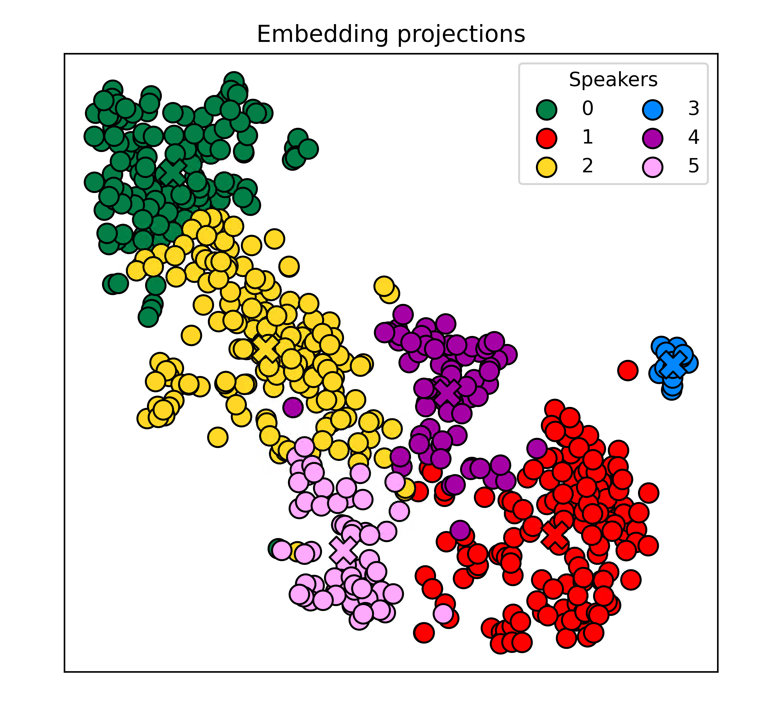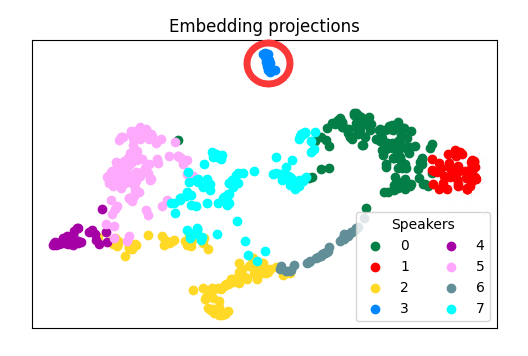A command-line tool for separating vocal timbres
The encoder model train by total of 303 speakers for 52 hours data
ColorSplitter is a command-line tool for classifying the vocal timbre styles of single-speaker data in the pre-processing stage of vocal data.
For scenarios that do not require style classification, using this tool to filter data can also reduce the problem of unstable timbre performance of the model.
Please note that this project is based on Speaker Verification technology, and it is not clear whether the timbre changes of singing are completely related to the voiceprint differences, just for fun :)
The research in this field is still scarce, hoping to inspire more ideas.
Thanks to the community user: 洛泠羽
Implemented automatic optimization of clustering results, no longer need users to judge the optimal clustering results themselves.
splitter.py deleted the --nmax parameter, added --nmin (minimum number of timbre types, invalid when cluster parameter is 2) --cluster (clustering method, 1:SpectralCluster, 2:UmapHdbscan), --mer_cosine to merge clusters that are too similar.
New version tips
-
Run
splitter.pydirectly with the default parameters by specifying the speaker. -
If the result has only one cluster, observe the distribution map, set
--nminto the number you think is reasonable, and runsplitter.pyagain. -
The optimal value of
--nminmay be smaller than expected in actual tests. -
The new clustering algorithm is faster, it is recommended to try multiple times.
-
The emotion classification function has now been implemented and can be called through the
--encoder emotionfunction. Go to when using https://huggingface.co/audeering/wav2vec2-large-robust-12-ft-emotion-msp-dim/tree/main Downloadpytorch_Model.binis placed in thewav2vec2-large-robust-12-ft-emotion-msp-dimdirectory. -
You can also use
--encoder mixto filter audio that matches two similar features at the same time. This feature can help you filterGPT SoVITSorBert-VITS2.3prompts.
- Correctly trained weights
- Clustering algorithm optimization
- SSL(Waiting for the wespeaker work done)
- emotional encoder
- embed mix
It works normally under python3.8, please go to install Microsoft C++ Build Tools
Then use the following command to install environment dependencies
pip install -r requirements.txt
Tips: If you are only using the timbre encoder, you only need to install the CPU version of pytorch. In other cases, it is recommended to use the GPU version.
1. Move your well-made Diffsinger dataset to the .\input folder and run the following command
python splitter.py --spk <speaker_name> --nmin <'N'_min_num>
Enter the speaker name after --spk, and enter the minimum number of timbre types after --nmin (minimum 1, maximum 14,default 1)
Tips: This project does not need to read the annotation file (transcriptions.csv) of the Diffsinger dataset, so as long as the file structure is as shown below, it can work normally
- input
- <speaker_name>
- raw
- wavs
- audio1.wav
- audio2.wav
- ...
The wav files are best already split
2. (Optional) Exclude outliers as shown in the figure below
As shown, cluster 3 is obviously a minority outlier, you can use the following command to separate it from the dataset
python kick.py --spk <speaker_name> --clust <clust_num>
The separated data will be saved in .\input\<speaker_name>_<n_num>_<clust_num>
Please note that running this step may not necessarily optimize the results
**3. After you select the optimal result you think, run the following command to classify the wav files in the dataset
python move_files.py --spk <speaker_name>
The classified results will be saved in .\output\<speaker_name>\<clust_num>
After that, you still need to manually merge the too small clusters to meet the training requirements
4. (Optional) Move clean_csv.py to the same level as transcriptions.csv and run it, you can delete the wav file entries that are not included in the wavs folder

